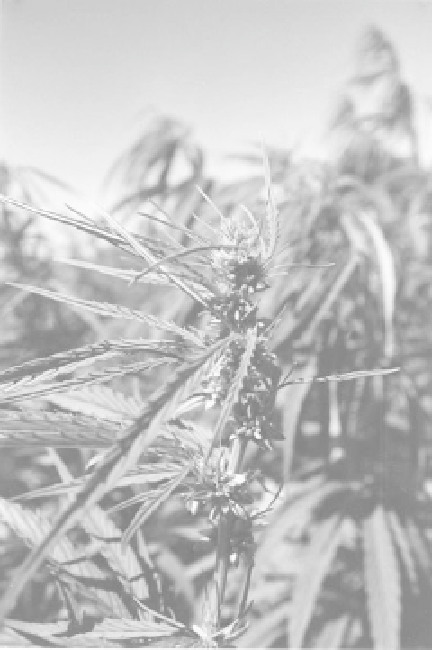Agriculture Reference
In-Depth Information
Finally, the difficulties subsequently
encountered in the development of varieties
led to a refocusing of work, in particular
towards monoecious varieties. More specifi-
cally, work concentrated on the monoecious
trait in order to try and eliminate masculinized
monoecious forms.
and female plants differ both morphologically
and physiologically. The vegetative phase of
the male plant is shorter by approximately 6
weeks than that of the female plant. This sex-
ual dimorphism results in a crop that is not uni-
form, demonstrating marked differences in
plant maturity (Fig. 4.2).
Table 4.1.
Comparison between monoecious and
dioecious varieties - D19 is dioecious; Fedora 19
is monoecious. (i) Identical maturation. Superior
yield seen in monoecious varieties. (ii) Other
advantages: mechanical harvesting facilitated;
homogenous crop obtained. Data from the FNPC.
4.3.2 Biotechnology
Given the disproportionately heavy investment
required for biotechnological work to be con-
ducted in the hemp industry, relative to the size
of the industry, it is not surprising that little
such work has been undertaken. The results of
this work will be presented in Chapters 5
and 6 of this topic.
There have been no studies to date seek-
ing to produce genetically modified hemp,
therefore no GMO varieties of hemp.
PSP
EC (%)
PSE
PG
D19
7.77
38.42
2.99
6.32
Fedora 19
9.18
37.29
3.42
9.73
Note
: PSP = yield in dry stems (t/ha); EC (%) = percent-
age of bark on the stems; PSE = yield in bark (t/ha); PG =
yield in grain/seeds (100 kg (ql)/ha).
4.3.3
Selection criteria definitions
The monoecious varieties
RECAP OF THE BACKGROUND TO THIS SUBJECT
.
The
disappearance of the labour force necessary
for the harvesting of hemp led to its mechani-
zation. Both the production of agricultural seed
and the industrial cultivation of hemp fibre
were affected by this change.
•
Seed production: saw a 35-40% reduc-
tion in seed production as there was no
equipment available for the harvesting of
seeds.
Industrial hemp production: inferior yields
•
(Table 4.1) seen due to the heterogeneity
of the harvested materials and the absence
of harvesting equipment. This led to the
harvesting of plants during the flowering
period, before the male plants aged and
dried and well before the maximum yield
for hurd and fibre was attained.
SEX OF THE PLANT
.
Hemp is naturally dioecious.
That is, the male and female flowers are not
found on the same plant (Fig. 4.9). The male
Fig. 4.9.
Monoecious hemp.




